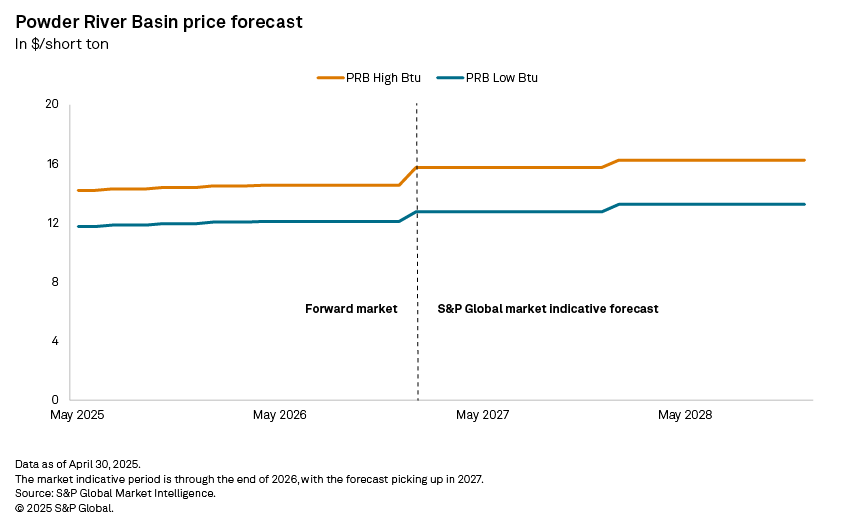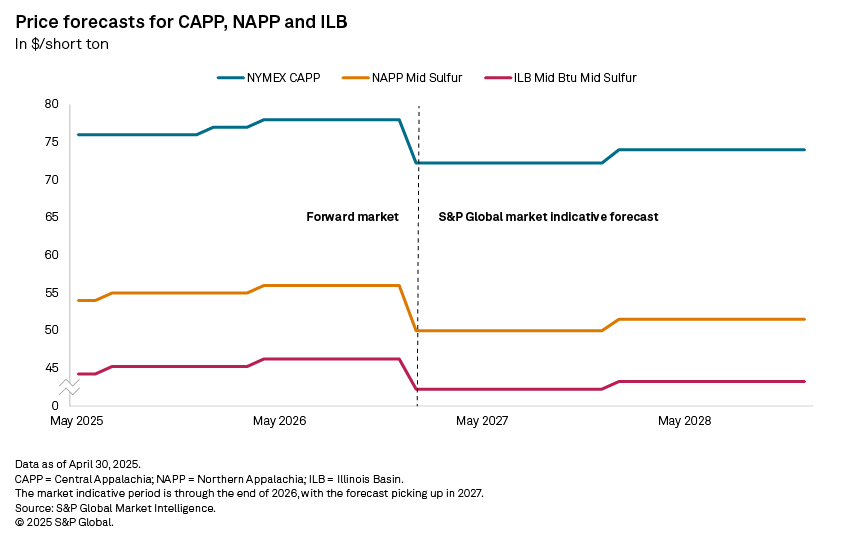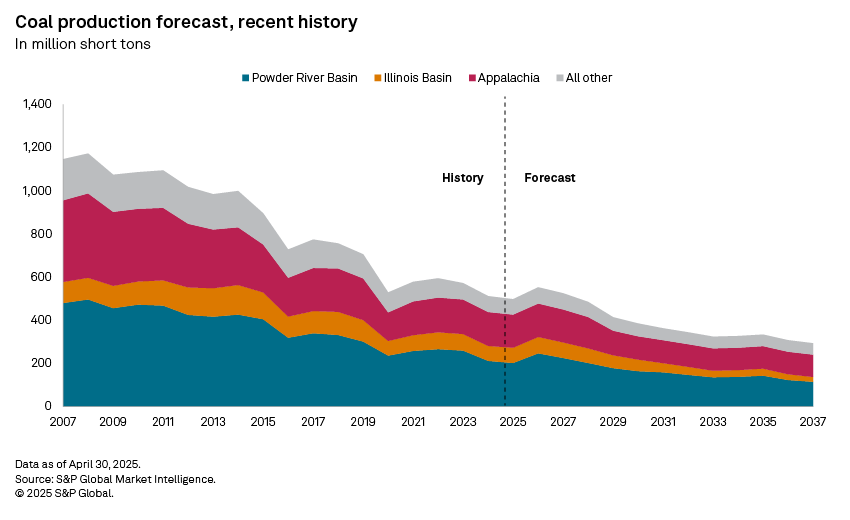Featured Topics
Featured Products
Events
S&P Global Offerings
Featured Topics
Featured Products
Events
S&P Global Offerings
Featured Topics
Featured Products
Events
S&P Global Offerings
Featured Topics
Featured Products
Events
Financial and Market intelligence
Fundamental & Alternative Datasets
Government & Defense
Banking & Capital Markets
Economy & Finance
Energy Transition & Sustainability
Technology & Innovation
Podcasts & Newsletters
Financial and Market intelligence
Fundamental & Alternative Datasets
Government & Defense
Banking & Capital Markets
Economy & Finance
Energy Transition & Sustainability
Technology & Innovation
Podcasts & Newsletters
Research — May 15, 2025

By Steve Piper
US domestic coal market prices staged a modest rally in April, even as natural gas prices eased. Natural gas prices remain strong for this time of year, however, and combined with reduced coal inventories seen earlier this year, continue to support firmer steam coal demand in 2025.
Higher natural gas prices are expected to improve the economic competitiveness of coal generation through 2027, a welcome prospect for steam coal producers burdened by low demand for the last several years. Low natural gas storage levels going into this spring will add to the demand boost, but much of this will go to reducing surplus coal inventories. Beyond 2027, the US coal market is forecast to come under increasing pressure from the expansion of zero-carbon electricity incentivized by the Inflation Reduction Act. In aggregate, the S&P Global Market Intelligence Power Forecast projects 44.2 GW of coal plant retirements by 2035, while 797.7 GW of renewable capacity is forecast to come online. Coal plants are forecast to experience a dramatic reduction in generation over this period, as US electricity demand for coal declines by 46.8%, and generation from coal plants accounts for just 7.1% of total generation.

Forward natural gas prices remain firm through the spring months, which is forecast to improve demand for coal over the next two to three years. While the need to first reduce surplus coal stockpiles is forecast to constrain 2025 aggregate production to 498 million short tons (MMst), steam coal demand will stay robust through 2027. After 2027, we forecast that the rapid growth of renewable generation will reduce coal plant capacity by 44.2 GW between now and 2035 and cut overall US coal generation by 46.8%.

Movements in coal prices were modest during April, with domestic coal making modest gains on headroom versus natural gas. Benchmark export coal prices held flat: The CAPP region export benchmarks closed April at $78.00/short ton, NYMEX CAPP at $76.00/short ton, and NAPP Pittsburgh Seam 13,000 Btu per pound at $54.00/short ton. Domestic coal eased higher, with Illinois Basin 11,500 mid-sulfur gaining $1.00/short ton, or 2.3%, to $45.25/short ton, while the NYMEX Powder River Basin benchmark gained 10 cents/short ton to $14.30/short ton.
Natural gas prices trended lower in April on milder weather. Henry Hub spot gas opened at $3.89/MMBtu and moved to a daily high of $4.21/MMBtu the first week before falling to close the month at $3.17/MMBtu. Spot prices averaged $3.46/MMBtu for the month. The break in prices and demand allowed for storage refill. Seasonal net inventory injections began in April, with working gas at 2,041 Bcf as of April 25, 5 Bcf above the five-year average and 435 Bcf below the surplus levels of 2024. With storage at essentially normal levels, natural gas prices may ease in May before summer weather again drives demand.
Regional gas market discounts generally held during April. Chicago Gate averaged $3.07/MMBtu, a 39-cent/MMBtu discount to Henry Hub. TCO Pool's discount eased to 54 cents/MMBtu at $2.92/MMBtu, while TETCO M3's discount was 56 cents/MMBtu at $2.90/MMBtu. SoCal Border's discount came in at $1.37/MMBtu for an average monthly spot price of $2.09/MMBtu.
The US Energy Information Administration estimated January 2025 coal stockpiles at 114 MMst, a 14-MMst reduction from December. With another large drawdown likely to be reported for February of this year, surpluses that built up during the past year may be cleared by early summer.

Current forward pricing for Powder River Basin coal reflects high inventories this year, with headroom to increase production against natural gas prices in 2026–2027. The inventory overhang may restrain price growth, but inventories may be normal by midyear. After 2027, declining demand will restrain price growth.
Bituminous coal price levels are mainly driven by export markets, with today's price levels making bituminous domestic coal generation less competitive against natural gas produced in the US Northeast. The recent rally in eastern natural gas prices may nevertheless boost first-half 2025 demand. Meanwhile, seaborne coal demand is forecast to decline modestly (1.9%) relative to 2024.

Pricing benchmarks exceeding $65/short ton indicate sustainable returns on eastern bituminous coal. After declining in 2024, bituminous coal demand for electric generation is forecast to hold steady through 2027 on higher electricity demand and more supportive natural gas prices. Declines in steam coal demand resume after 2027, and overall Eastern US coal demand is forecast to decline 62 MMst from 2025–2030.
Outlook for US coal production, demand
For the four weeks ending April 26, coal shipments again averaged 10.1 MMst, a full 26% higher than this time in 2024. Continued strong deliveries indicate boosted generation demand against higher natural gas prices.
The chart below compares the current production forecast with recent history. We forecast increased coal demand against higher natural gas prices through 2027. However, production will need to fall this year to clear inventory surpluses. This will constrain 2025 coal production to a forecast 498 MMst, a decline of 14 MMst (2.7%) from 2024 levels. Coal generation is forecast to further gain market share from natural gas through 2027, until relative coal and gas pricing normalizes and expanding green energy again puts pressure on coal generation. The overall coal market, including domestic demand and exports, is forecast to decline by 152 MMst between 2025 and 2030.
Production outlook — Powder River Basin
Preliminary first-quarter 2025 production reports of the US Mine Safety and Health Administration (MSHA) indicate quarter-end production at 54.9 MMst, an annualized rate of 219.4 MMst. Production is forecast to ease to 202 MMst in 2025, to balance inventory levels. With inventory levels normalized, production is forecast for modest growth through 2027 against higher natural gas prices. By 2030, S&P Global Commodity Insights projects that coal generation retirements in the Midwest and a substantial expansion of wind generation in the Powder River Basin's core markets will shrink coal demand to 164 MMst, further declining to 143 MMst through 2035.
Production outlook — Illinois Basin
We forecast stable annual production through 2027. After 2027, the expansion of wind generation incentivized by the Inflation Reduction Act and announced coal retirements are forecast to erode Illinois Basin coal demand. Coal production in the Illinois Basin is forecast to fall to 54 MMst by 2030, further declining to 33 MMst by 2035.
Production outlook — Appalachian basins
Preliminary first-quarter 2025 production reports of the MSHA indicate quarter-end production at 36.4 MMst, or an annualized rate of 145.4 MMst. With export into seaborne metallurgical markets forming an increasingly larger portion of Appalachian coal demand, the region's aggregate demand is less sensitive to natural gas price competition than in domestic producing regions of the Powder River and Illinois basins. While the Illinois Basin and Powder River Basin are forecast for improved demand against natural gas generation, gains in Appalachian coal will be more limited. Reduced electricity demand offset by firmer exports will drive production down to a forecast 153 MMst in 2025. As remaining domestic demand erodes with only modest offsets from export growth, Appalachian production is forecast to fall to 108 MMst by 2030.

Further information
Market indicative coal forecasts by Commodity Insights represent forward curves for spot-traded instruments analogous to a strip of contracts. The shorter tenors — current year and prompt year, plus additional years, if available — are driven by the observed/assessed market. The longer tenors — typically forecast years three to 20 for physically assessed markers — are driven by fundamental estimates of cash costs of production, accepted returns to capital, regional productive capacity, and forecast supply and demand. For the long-tenured portion of the curve, Commodity Insights forecasts prices for specific coal markers and defines the remaining markers via historical spreads.
This article was published by S&P Global Market Intelligence and not by S&P Global Ratings, which is a separately managed division of S&P Global.
Adam Wilson contributed to this article.
Regulatory Research Associates is a group within S&P Global Commodity Insights.
S&P Global Commodity Insights produces content for distribution on S&P Capital IQ Pro.
Data visualization by Joseph Reyes and Chris Allen Villanueva. Cartography by Leigh Lunas.
For wholesale prices and supply and demand projections, see the S&P Global Market Intelligence Power Forecast.
Regulatory Research Associates is a group within S&P Global Commodity Insights.
S&P Global Commodity Insights produces content for distribution on S&P Capital IQ Pro.
Theme
Location
Products & Offerings
Segment